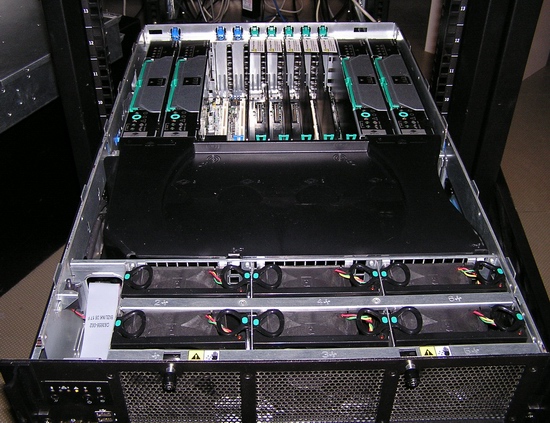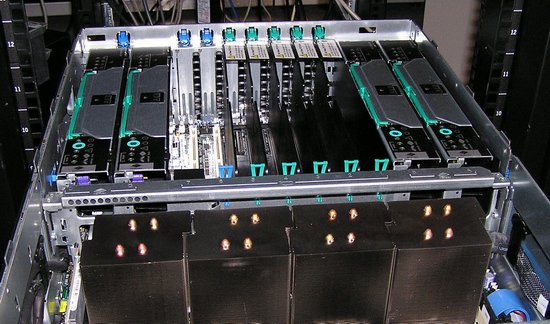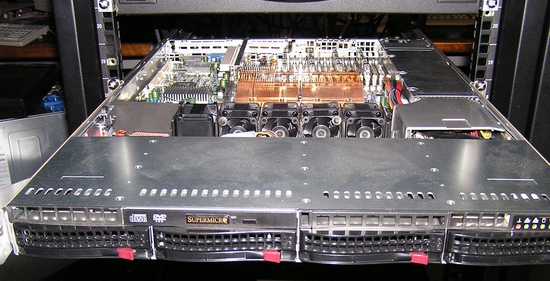Intel's newest Quad Xeon MP versus HP's DL585 Quad Opteron
by Johan De Gelas on November 10, 2006 12:00 PM EST- Posted in
- IT Computing
Intel SR6850HW4 Server
Our server was not a simple demo system, but a complete Intel Server system solution: the SR6850HW4 server. It is an enormous 6U rack/pedestal server, also available in a slimmer 4U form as the SR4850HW4. The main difference is that the 4U server has 5 (6U:10) disk bays, a bit less cooling, and smaller and slightly less powerful power supplies.

Below you can see the massive heatsinks used to cool the Xeon 71xx down.

As the new quad socket Xeon 71xx CPU fits in a 4U server, we can easily compare it with one the most popular quad Opteron servers: the HP DL585.
HP ProLiant DL585 version 2006
The HP ProLiant DL585 available in the labs was not the recently introduced DL585G2 which features DDR2, the new AMD Opteron socket F and 2.5 inch SAS drives. It is a small evolution of the HP DL585 which we reviewed back in 2004. Back then, each of the four CPU boards had 8 memory slots and supported up to 16GB (8x2GB) of DDR-266, for total of 64GB RAM. The original HP was able to use up to 48GB of DDR-333.
The latest DL585 can use 4GB DIMMs, allowing it to access no less than 128GB of DDR266. It can also use 32GB of fast DDR-400 or 64GB of DDR-333, which is very impressive. Below you can find a schematic overview of the latest DL585 technology.

The Opteron keeps a few very important advantages over the Xeon MP, not the least of which is a very elegant platform design. The quad dual core configuration generates more cache coherency traffic, as the 8 cores of the Opteron have to keep 8 L2 caches coherent while the Xeon MP has to keep track of 4 L3 caches. However four 4GB/s full duplex point to point connections make this traffic flow very smoothly while each pair of Xeon MPs have to share a 6.4GB/s half-duplex bus. The Opterons also have a fast 4.8GB/s full duplex point-to-point connection to the I/O chips.
Supermicro SS6015b-8+ server
For the price of a 4U quad socket server you can get several dual socket 1U/2U servers. There are several reasons why you would still prefer to buy the more expensive 4U server: more disk bays, more RAS features, more full height expansion slots, and of course more performance. Depending on your needs one these factors might be the decisive one. In the case of the 4U servers reviewed here, direct attached storage will not be the deciding factor, as you can get 4 or 5 disk bays in a 1 or 2U server too. If performance is the critical factor, it is clear that we must include a 1U or 2U server to see how much more performance you gain if you choose the quad socket machine.
Enter the Supermicro SS6015B-8+, which is equipped with Supermicro's X7DBR-8+ dual Xeon "Bensley platform" server board, based on the Intel 5000P chipset. While it doesn't have the RAS features of the 4U machines (for example, it doesn't have redundant PSUs), it can compete on all other points. In terms of RAM capacity for example, the Supermicro motherboard has sixteen (!) 240-pin DIMM slots that can support up to 64GB of ECC DDR2-667/533 FB-DIMMs. You can also trade in some RAM capacity for RAS: the similar SS6015B-3RV features "only" 8 DIMM slots but two 650W PSUs. The SS6015-8+ is also equipped with a SCSI or SATA backplane that offers 4 drive bays.

Due to the 1U form factor, you have to sacrifice a bit of expandability. One 133 MHz PCI-X slot can support two different riser cards, but not simultaneously. You have to choose between the PCIe riser card and the PCI-X one.
We are well aware that this particular Supermicro server is not a direct competitor. However, a similar 2U server like the 6025B will give almost the same performance numbers. The 6025B Server offers 8 drive bays, redundant power supplies and 6 expansion slots. So we are basically using the SS6015b-8+ as a "performance reference". We will try to answer the question: when do four Xeon MP or Opterons make sense, and how does it compare to the best dual Xeon available, the Xeon DP 5160?
Our server was not a simple demo system, but a complete Intel Server system solution: the SR6850HW4 server. It is an enormous 6U rack/pedestal server, also available in a slimmer 4U form as the SR4850HW4. The main difference is that the 4U server has 5 (6U:10) disk bays, a bit less cooling, and smaller and slightly less powerful power supplies.

Below you can see the massive heatsinks used to cool the Xeon 71xx down.

As the new quad socket Xeon 71xx CPU fits in a 4U server, we can easily compare it with one the most popular quad Opteron servers: the HP DL585.
HP ProLiant DL585 version 2006
The HP ProLiant DL585 available in the labs was not the recently introduced DL585G2 which features DDR2, the new AMD Opteron socket F and 2.5 inch SAS drives. It is a small evolution of the HP DL585 which we reviewed back in 2004. Back then, each of the four CPU boards had 8 memory slots and supported up to 16GB (8x2GB) of DDR-266, for total of 64GB RAM. The original HP was able to use up to 48GB of DDR-333.
The latest DL585 can use 4GB DIMMs, allowing it to access no less than 128GB of DDR266. It can also use 32GB of fast DDR-400 or 64GB of DDR-333, which is very impressive. Below you can find a schematic overview of the latest DL585 technology.

The Opteron keeps a few very important advantages over the Xeon MP, not the least of which is a very elegant platform design. The quad dual core configuration generates more cache coherency traffic, as the 8 cores of the Opteron have to keep 8 L2 caches coherent while the Xeon MP has to keep track of 4 L3 caches. However four 4GB/s full duplex point to point connections make this traffic flow very smoothly while each pair of Xeon MPs have to share a 6.4GB/s half-duplex bus. The Opterons also have a fast 4.8GB/s full duplex point-to-point connection to the I/O chips.
Supermicro SS6015b-8+ server
For the price of a 4U quad socket server you can get several dual socket 1U/2U servers. There are several reasons why you would still prefer to buy the more expensive 4U server: more disk bays, more RAS features, more full height expansion slots, and of course more performance. Depending on your needs one these factors might be the decisive one. In the case of the 4U servers reviewed here, direct attached storage will not be the deciding factor, as you can get 4 or 5 disk bays in a 1 or 2U server too. If performance is the critical factor, it is clear that we must include a 1U or 2U server to see how much more performance you gain if you choose the quad socket machine.
Enter the Supermicro SS6015B-8+, which is equipped with Supermicro's X7DBR-8+ dual Xeon "Bensley platform" server board, based on the Intel 5000P chipset. While it doesn't have the RAS features of the 4U machines (for example, it doesn't have redundant PSUs), it can compete on all other points. In terms of RAM capacity for example, the Supermicro motherboard has sixteen (!) 240-pin DIMM slots that can support up to 64GB of ECC DDR2-667/533 FB-DIMMs. You can also trade in some RAM capacity for RAS: the similar SS6015B-3RV features "only" 8 DIMM slots but two 650W PSUs. The SS6015-8+ is also equipped with a SCSI or SATA backplane that offers 4 drive bays.

Due to the 1U form factor, you have to sacrifice a bit of expandability. One 133 MHz PCI-X slot can support two different riser cards, but not simultaneously. You have to choose between the PCIe riser card and the PCI-X one.
We are well aware that this particular Supermicro server is not a direct competitor. However, a similar 2U server like the 6025B will give almost the same performance numbers. The 6025B Server offers 8 drive bays, redundant power supplies and 6 expansion slots. So we are basically using the SS6015b-8+ as a "performance reference". We will try to answer the question: when do four Xeon MP or Opterons make sense, and how does it compare to the best dual Xeon available, the Xeon DP 5160?










88 Comments
View All Comments
DigitalFreak - Friday, November 10, 2006 - link
No, the DL580 is a quad socket as well.Although it's probably what you already had on hand, the new DL585G2 offers a lot of what you said the DL585 lacked (PCI-E, etc.)
JohanAnandtech - Saturday, November 11, 2006 - link
My bad, by reading "Woodcrest" (which is wrong) I thought there was some DL580 model that was dual socket that I wasn't aware off. So basically the DL580G4 is Tulsa based, I think the DL585 is a more interesting competitor for our Intel server.The fastest DL580G3 are all Paxville (or even older based) so not interesting for comparison... the spec numbers make it clear it is pretty bad performer.
severian64 - Friday, November 10, 2006 - link
Jason,If you are read this, please include the following benchmarks on Windows for the Quad Intel vs Quad Operton if you do a quad shootout on windows:
1) Windows 2003 Server x86-64 , SQL Server 2005 x86-64
2) Windows 2003 Server x86-32, SQL Server 2005 x86-32, Exchange 2003
For the SQL Server 2005 tests please test all aspects of the database such as SQL Server Integration Services not just SQL statements.
Also, the tests would be most usefull if they were done with 4GB , 8GB and 16GB configs.
Thanks,
Severian.
Brokersml - Wednesday, March 4, 2020 - link
https://currency-trading-brokers.com/forex-compari...Topteni221 - Tuesday, March 17, 2020 - link
Hi folks, just to share some useful website resource here, thanks!The https://ytmp3.ch/">Ytmp3 online video downloader support all web browsers to Download YouTube to MP3 & MP4 Official
https://y2mate.ch/">Y2mate website.
Best https://keepvid.ch/">Keepvid website.
Top ten https://topten.ai/image-upscalers-review/">image upscaler review.
Best https://videoeditor.best/">video editor reviews of 2020.
Easy online https://memegenerator.site/">meme generator sites.
Keepvid688i - Wednesday, March 18, 2020 - link
The Best https://topten.ai/video-enhancer-review/">Video Enhancer Software reviews 2020.The Best free online https://keepvid.ch/en/youtube-to-mp4">YouTube to mp4 tools.
New https://flvto.ch/">youtube converter website.
The Best and stable https://2conv.ch/">YouTube Downloader
New https://ytmp3.ch/">ytmp3 website
https://ja.dvdfab.cn/ura/pornhub-adult-video-downl...">Pornhub ダウンロード
BettyNuh - Thursday, March 19, 2020 - link
MEET HOT LOCAL GIRLS TONIGHT WE GUARANTEE FREE SEX DATING IN YOUR CITY CLICK THE LINK: http://veryhotgirls.best/Y2mateS628 - Tuesday, March 24, 2020 - link
Hi, just came across your website, really appreciate your works!Would like to post some useful links, hope you like it.
https://flvto.ch/">Youtube Converter
https://y2mate.ch/">y2mate
https://keepvid.ch/en/youtube-video-downloader">Youtube video downloader
https://ytmp3.ch/">Youtube to mp3
https://listentoyoutube.ch/ja/youtube-to-mp3-sites">YouTube MP3 変換
https://youtufab.com/download-youtube-mp4-1080p">Youtube to mp4
Steveinema - Tuesday, March 31, 2020 - link
General specialist manhattanThe part of General building New York is to transfer to the client the whole center overall, and certainly not such as separately done job. Of certain relevance is actually the job of the basic professional during the course of the big development of apartment of residential style, commercial facilities, business centers.
https://grandeurhillsgroup.com/">hospitality interior new york;
Industrial structures.
Today, the list of building companies consists of different business interior design. An financier as well as a consumer can invest a considerable amount of time-solving on all company concerns. A even more reasonable service is to entrust this function to General building NY.
Keepvid343r - Tuesday, March 31, 2020 - link
Hi guys, just came across your wonderful website and would like to share some free userful resource.The Best free online https://keepvid.ch/pt/youtube-to-mp3">YouTube mp3 tools.
New https://flvto.ch/de/youtube-converter">youtube converter website.
The Best and stable https://2conv.ch/">video Downloader
New https://ytmp3.ch/">youtube to mp3 website.